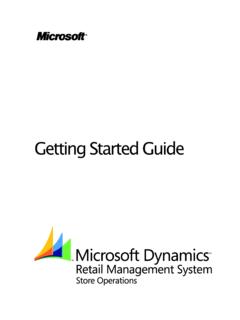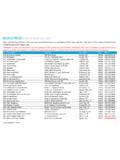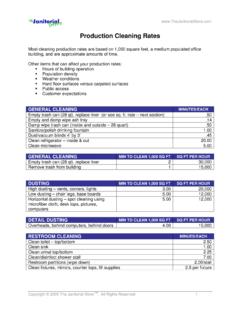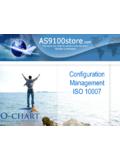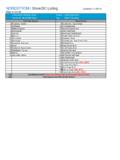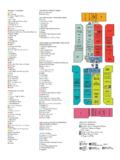Transcription of Store Operations User's Guide - Restaurant and Retail ...
1 user s Guide Information in this document, including URL and other Internet Web site references, is subject to change without notice. Unless otherwise noted, the example companies, organizations, products, domain names, e-mail addresses, logos, people, places and events depicted herein are fictitious, and no association with any real company, organization, product, domain name, e-mail address, logo, person, place or event is intended or should be inferred. Complying with all applicable copyright laws is the responsibility of the user . Without limiting the rights under copyright, no part of this document may be reproduced, stored in or introduced into a retrieval system, or transmitted in any form or by any means (electronic, mechanical, photocopying, recording, or otherwise), or for any purpose, without the express written permission of Microsoft Corporation.
2 Microsoft may have patents, patent applications, trademarks, copyrights, or other intellectual property rights covering subject matter in this document. Except as expressly provided in any written license agreement from Microsoft, the furnishing of this document does not give you any license to these patents, trademarks, copyrights, or other intellectual property. 2006 Microsoft Corporation. All rights reserved. Microsoft, Microsoft Dynamics, Windows, and Great Plains are either registered trademarks or trademarks of Microsoft Corporation in the United States and/or other countries. The names of actual companies and products mentioned herein may be the trademarks of their respective owners. Part number: X13-35083-01 Publication date.
3 November 2006 Contents i Contents Introduction 1 Getting started 3 Using Store Operations for the first time 3 Starting and exiting Store Operations 4 Setting up your Store Operations database 5 Database key points 5 Collecting basic information 6 Administrator program 13 Overview 13 Manager program 15 Overview 15 Navigating through Manager 16 Setting up security structure 20 Working with your database 26 Controlling pricing, sales, and promotions 58 Tracking inventory 66 Purchase orders 72 Inventory transfers 77 Tracking sales 82 Managing customers 86 Managing employees 94 Generating reports 101 Using labels 115 Processing receipts and journals 130 Interfacing with accounting 137 ii Store Operations user s Guide Exporting to accounting programs 146 Housekeeping 156 Reference 157 File menu 157 Database menu 179 Inventory menu 300 Journal menu 332 Wizards menu 340 Reports menu 356 Utilities menu 357 Point of Sale program 375 Overview 375 Moving around in the POS program 376 Processing daily POS activities 398 How to 417 Appendix A Value Added Tax (VAT) 453 How does VAT work?
4 453 Setting up for VAT 454 VAT accounting integration 455 Glossary 457 Index 471 Introduction 1 Introduction Welcome to Microsoft Dynamics Retail Management System Store Operations . Whether you have a single Store or multi- Store operation, you can use Store Operations to automate all your point-of-sale (POS) and back-office tasks. Store Operations gives you the only total software solution that handles today's POS and management grows as big as your goals expand. Store Operations resolves the complexities of multi-channel retailing, providing a common system to manage sales through physical stores , catalogs, phone orders, and the Web. Store Operations manages every aspect of your Store with complete security and absolute control.
5 The software flexes to the way you sell, learns how you manage, equips you with the same tools that Retail giants use, and gives detailed, blazing fast reports on exactly what's happening in every department, for every item. When you expand to the Web, Store Operations has already paved the road. Manage all your sales, inventory, customers, and records in one easy package. As you expand, keep the same database, the same interface. Both will scale up seamlessly. You and your staff keep the same powerful Store Operations tools with no retraining. Store Operations Manager - Automates back-office Operations , including purchase order creation, receiving inventory and printing price tags/labels, customer database maintenance, and report generation.
6 Beyond basic inventory control features, its advanced capabilities promote optimum inventory levels, control costs, set pricing, and export to popular accounting programs. Store Operations POS - Provides the graphical user interface and handles all the point-of-sale functions at the checkout terminals. The cashier can ring up sales, perform data lookup, accept tenders, and generate work orders, back orders, and quotes. It supports multiple POS devices ( , scanners, printers, pole displays, etc.) Store Operations Administrator - Use Administrator to connect to the database server, create databases, import databases, upgrade the database, back up data, and configure your database for each of the point-of-sale registers. Getting started 3 Getting started Using Store Operations for the first time If you are using Store Operations for the first time, there are some important things you should know.
7 For Store Operations to operate properly, you must activate the software. Activation is necessary on each computer (register) where you intend to run Store Operations POS. You can run Store Operations Manager without activation. Copy protection devices ("dongles") are no longer required. When installing the software, Store Operations creates a default cashier with the ID number "1" and password "password". Use this combination to initially log onto Store Operations Manager. You should then change the password. When Store Operations is first installed, a sample database is provided to allow the software to run immediately. This database contains basic sample information for a fictitious Store . You can use this database to learn about Store Operations , or as a starting point for your own Store s information.
8 For instructions on how to load the sample database, see Store Operations Administrator Online Help or the Getting Started Guide . Before you can process sales at the register, you need to set up and/or modify the Store Operations database. For more information, see Database key points. 4 Store Operations user s Guide Starting and exiting Store Operations Starting Store Operations 1 On the Windows Start menu, point to Programs, point to Microsoft Dynamics RMS, and then click either Store Operations Manager or Store Operations POS. 2 Type the user ID and password provided to you by your Store Operations administrator. The user ID will be used by the system to validate the password and to determine your rights for accessing the information in the database.
9 To start Manager, you must log on with a user account that has been granted manager rights. Note When a Store Operations database is created, a default user account is automatically set up to allow you to log in and perform initial database setup. The user ID for this account is "1" and its password is "password". After you set up your database, change the password for this account. Exiting Store Operations POS 1 Tender or cancel the current transaction (if any). 2 Press Esc, and then click Yes to confirm that you really want to close Store Operations POS. Note Only cashiers who have the privilege to exit Store Operations POS will be able to complete this procedure. Exiting Store Operations Manager On the File menu, click Exit.
10 Setting up your Store Operations database 5 Setting up your Store Operations database Database key points This section assumes you have successfully created your Store Operations database using Store Operations Administrator. For more information, see Deployment Guide in the Getting Started Guide . This section will show you how to set up your database with the basic inventory, tax, cashier, payment type, and register information. If you imported an existing QuickSell 2000 database or are using a sample database, you do not need to set up the database from scratch. Just use the Manager program to modify the existing database information as needed. If you have never used Store Operations , you need to set up the database from scratch.
